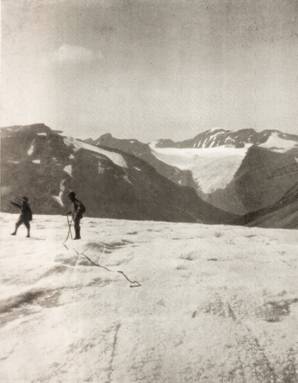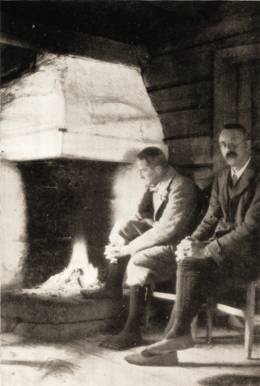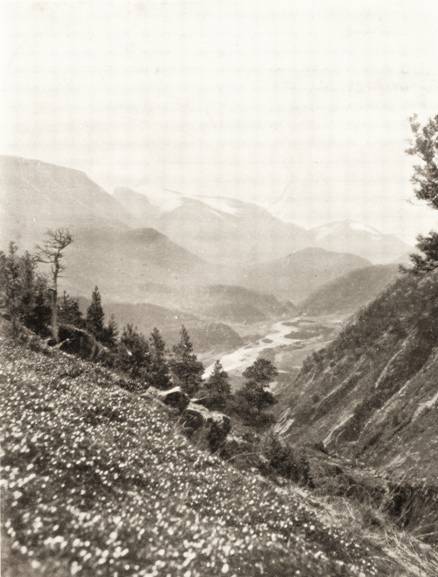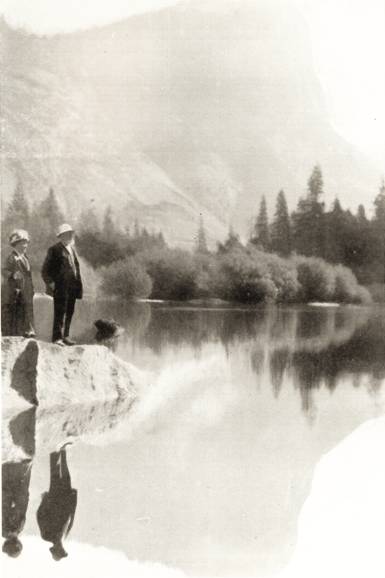Members’ Holidays In 1910
G. Winthrop Young was in the Oberland and Zermatt districts from July 31 to Aug. 24 and traversed the Blümlisalphorn from Oeschinen to Gries A1p (12 hrs.). and the Gspaltenhorn from the Gamchilucke to Mutthorn Hut (10 hrs.);._ climbed the Lauterbrunner Breithorn, and by the Wetterlücke to Ried (stormy, 10 ½ hrs.); also the Butsch-horn, from Randa, (guideless, snowstorm, 14 hrs.), Trift Glacier, direct ascent of ice-fall (guideless); Ober Gabelhorn (guideless, 13 hrs.); Matterhorn (16 hrs.); Dent d’Herens (variation route 10 hrs.); Dent Blanche (guideless, 8 ½ hrs.); Kienhorn, traverse and ascent of half of Teufelsgrat (dangerous thunderstorm, 12 hrs.); Trifthorn and Rothhorn, traverse from and to Zermatt, first ascent of S.W. wall of Rothhorn and first traverse of Rothhorn-Gabel-Joch (13 hrs.).
F. Botterill took a châlet at Arolla, where he spent the summer and did much climbing, being visited by Brodrick, Hazard, Rule, H. Williamson, and others.
A. Rule was climbing at Easter on Doe Crags and Pavey Ark; walked in one day from Coniston over Old Man, Wrynose, Crinkle Crags, Bow Fell and Eskhause to Wasdale Head and climbed the gullies on Great End.
At Whitsuntide he was at the Y.R.C. Camp at Gaping Ghyll in charge of survey party and surveyed Mud Chambers and old S.E. Passage; was at Gaping Ghyll on June 12 with Y.R.C. party and surveyed Spout Tunnel with Booth, Brodrick, Davidson, and Wingfield.
In the Alps from July 23 to August 24 walked with H. Brodrick from Frutigen to Lenk over Gemmi Pass and from Sion to Arolla; climbed La Roussette by N.E. Ridge with Brodrick and Hazard; traversed Petit Dent de Veisivi with Brodrick and Botterill (guideless); with Botterill and A. Bilby (guideless), traversed the summits of Pointe de Vouasson and Mt. de l’Etoile; traversed Pigne d’Arolla, with Hazard (guideless); with Hazard and Botterill walked from Arolla to Aosta over the Col Collon and down the Valpelline; from Aosta to Courmayeur and up to the Pavillon Mt. Fréty, thence in bad weather up to Rifugio Torino and with Hazard and Botterill (guideless), over Col du Géant and by Mer de Glace to Argentiére’ and Martigny.
September 24-25. At the Y.R.C. Meet at Chapel-le-Dale.
G. W. Lloyd with the Rev. E. A. Aldridge was in the Tarentaise and Graians, and Zermatt District from July 27 to August 20:- Moutiers to Champagny-le-Haut; Champagny to Val d’Isère over the Col du Palet (8,721 ft.), Val d’Isère to Bonneval over the Col d’Iseran (9,085 ft.) to the Léchans Chalets ; traverse of Eastern Levanna (11,693 ft.) to Ceresole (with Victor Mangard as guide), to Pont Canavese, (Val d’Orco); Ronco, (Val Soana); and Cogne over Colle del Rancio (9,174 ft.). Attempt on the Grivola, (13,022 ft.) (with guide Gérard Gaspard and E. Jeantet porter) to within 600 feet of the summit when they found the dead bodies of the brothers Segato and returned for assistance, (see A. J., Vol. 25,p. 278). The Cima Leviona (9,738 ft.) with Mr. G. Yeld and his guide. To Val Tournanche and Breuil. Breuil to the Riffelalp over the Théodule Pass (10,000 ft.). The Riffelhorn (9,615 ft.) by the Sky Line Route with four others. The Riffelalp to Breuil by Théodule, Théodulhorn (with A. Dobson) along the Furggengrat and Furggjoch and return to Riffelalp by Théodule Pass.
W. H. Greenwood was at Fort William at Easter and climbed the Castle Ridge, Carn Mor Dearg – Nevis Ridge, and attempted the Tower Ridge but was driven back by mist and snow.
At Saas Fée in August and September and did the following without guides:- Mittaghorn; Egginer (and ridge); Sonnighorn; Mittelrück; Hinter Allalin; Fletschhorn (snowstorm throughout); Weissmies and Portiengrat (traverse in one day); Stellihorn; Stecknadelhorn; Ulrichshorn and connecting ridge; attempted Rimpfischhorn for 17 ½ hours, but failed owing to soft snow and avalanches; and (alone) Monte Moro Pass and Val Anzasca to Italian Lakes; Bernina Pass to Pontresina: Piz Languard, Mortel-hütte, Tschierva-hütte, Fuorcla Surlej, etc., Milan and Venice.
E. E. Roberts:- At Easter (with Addyman and Stobart), climbed Sgorr a Mhaim, Stob Ban, Ben Nevis by Castle Ridge, the Tower Ridge to the Tower, (under alpine conditions), and Carn Mor Dearg. Was in Dauphiné, (July 11 to August 4), with Davidson and Lamb:- Pic du Combeynot; Pic d’Arsine; Col Emil Pic and Pic de Neige Cordier; Pelvoux; Col de Sélé; Rateau; Meije, (traverse, first ascent of season); South and North Aiguilles d’Arve, Brêche de la Meije, and N. Pic des Cavales.
At Saas Fée, (Aug. 6-18), with W. H. Greenwood and Bishop and climbed Sonnighorn, Mittelrück, Weissmies and Portiengrat (complete traverse), Fletschhorn, Nadelhorn and Stecknadelhorn.
John J. Brigg:- Was at Montana in February for Winter Sport, at Feldberg at Easter for ski-ing and the Italian Lakes in May. He also went on a camping trip in Syria in September and ascended the highest points on the Lebanon (Dahr-el-Kodib 10,500 ft.), Mt. Hermon (9,050ft.), and Mt. Tabor (2,018 ft.).
“These mountains, though not difficult of ascent – horses may be ridden to their summits – are of interest through their position and associations. From the Lebanon we look down on the great cirque that surrounds the tiny remains of the ancient Cedars of Lebanon, and away beyond, across the gorge of Wadi Kanôbin are Tripoli and the Great Sea, whilst towards the sunrising beyond “the entering in of Hamath” lies the Euphrates valley, soon to become again one of the granaries of the world.
“So also Hermon looks westward and southward to “the coasts of Tyre and Sidon” and the hills of Galilee and Samaria, and eastward to the lava hills of the Hauran, where the Druses are to-day defying the Young Turk Army and the inevitable tax collector.
“Mount Tabor makes the most of its 2,000 ft. standing by itself, overlooking the plain of Esdraelon, the battlefield of ancient Palestine. On its summit, where once Barak gathered his ten thousand men, are monasteries, Greek and Latin, with a well-made path leading up to them. Away to the westward the eye wanders from Endor and Mt. Gilboa across the plain of Esdraelon to the ridge of Carmel and the Mediterranean.”
Harold Brodrick was with A. Rule at Arolla and climbed Les Rousettes by N.E. arête and traversed the Petits Dents de Veisivi. Also at Michelstown Caves at Easter with Hill and Wingfield; and at Gaping Ghyll several times; and a made a preliminary visit to the Matlock Caves.
W. A. Brigg was at the Feldberg at Easter; at Gaping Ghyll Camp at Whitsuntide; and (with Messrs. Eric Greenwood and William Garden) in Norway, (August 7-27):-
“To Turtegrö by Bergen to Voss (rail), Stalheim and Gudvangen (road), Skjölden (steamer). Climbed Skagastölstind, (with Ole Berge as guide), from Turtegrö, under perfect conditions, by Vigdal’s Chimney up and Heftye’s Chimney down; and then made a tour through Jotunheim, by the Keiserin to Skogadalsboen; by the Melkedal to Eisbugaren; to Nyboden (by motor launch down Lake Bygdin); by the Langedal to Gjendeboden and by motor launch on Lake Gjendin to Memuruboden; by the Memuru-brae and ‘Hejlstugu-brae to Spiterstulen and Röjshejm, by Baevertunsaeter to Krosboden; and by the Sogne-fjeld or Dale-fjeld to Turtegro.
“The weather for the first half at any rate was fine and hot, the tail end of the finest summer on the W. Coast for thirty years!
“There were no climbers, except half a dozen English and Norsk at Turtegrö, and very few mountaineers anywhere. Young Norway makes Jotunheim its playground much as we do Lakeland but in fewer numbers. The going is altogether over stones, scrub and reindeer moss, and the district is quite uninhabited and only made possible by mountain inns and saeters at convenient places in the valleys. The glacier passes are easy and the peaks not apparently difficult, the colouring rich, the daylight long, the way hard to miss, the living simple but good and remarkably cheap (3s. 4d. a day inclusive at some places) and the people charming. But for the seapassage – and it is a big “but” – no better place could be found for guideless mountaineering.”
Dr. Tempest Anderson was unable to get away further than the Geological Congress in August at Stockholm, going by Copenhagen and the Gotha Canal, returning by Gothenburg.
C. R. Wingfield had a few days skating and ski-ing in December 1909 and January and February 1910, and was at Almescliffe (Feb. 13), and Club Meet, Hill Inn, in September.
At Easter was at Mitchelstown surveying old Cave and part of new Cave with H. Brodrick and C. A. Hill.
At Whitsun was at Gaping Ghyll Camp and on 12 June was at Gaping Ghyll again, surveying Spout Tunnel.
June 25 – July 5; Sailed in “Sorata” 10 ton yawl, (with crew of 3 hands), from Douglas (I of Man) to Holyhead 5l knots, Aberdarron Bay 38 k., Fishguard 50 k., Milford Haven 37 k., and back to Dale Road 10 k., Falmouth 146 k., and Cowes 154 k.
August 7 – September 9. Sailed from Lowestoft in “Gwynfa” 60 ton yawl, (amateur crew), visited Brunsbuttel, Kiel Canal, Kiel, Great Belt, Copenhagen, up the Sound to Mälmo, back through Kiel Canal to Hamburg calling at Cuxhaven, Terschelling, Texel, Alkmaar, Amsterdam, Ijmuiden to Brightlingsea (about 1,400 knots).
September 24-26. Club Meet at Hill Inn.
James Buckley made an extended tour with his family around the world from February 1909 to October 1910.
Summary:- Voyage to Australia, (S.S. Asturias), via Gibraltar, Suez Canal and Colombo to Brisbane. Darling Downs, Cairns, (North Queensland), Kuranda, Barron Gorge and Falls (highest in Australia, 700 ft.), Bellenden Ker Mountain Ranges to Atherton.
Cruise by S.S. “Tofua,” 4,500 miles on Pacific Ocean, from Sydney to Auckland, N.Z., via the Fijis, Samoa (Apia) and Vavau, the Tongans (or Friendly Islands), Vavau, Neukalofa, &c., making many calls en route (22 days). Seven months in New Zealand, visiting the cities, farm stations (Napier District), New Plymouth, Mt. Egmont, Thermal Districts and Hot Lakes of Rotorua, Te Aroka, &c., in the North Island. Tour of the N. and S. Islands, visiting the Cold Lakes and Alpine districts in the South. Coaching through the Gorges of the Clutha, Otira and Buller to Nelson. Voyage across Pacific Ocean by the Fijis and Honolulu to Victoria, B.C.
To California, San Francisco, Yosemite Valley, Big Trees and Sierra Nevada. Three weeks in the Rocky Mountains, Glacier, Emerald Lake, Laggan, Banff, &c., and Great Lakes to Toronto. A summer in the Highlands of Ontario Lakes, &c.
Erik T. W. Addyman:- April 1909. Camp on Torver side of Walna Scar (with O. J. Addyman and Stobart), Great Gully on Doe Crags, Y.R.C. meet at Coniston, ascended Doe Crags by new route (since named the Giant’s Crawl) and moved the camp to Duddon Valley and thence to Taw House, Eskdale. Climbed Cam Spout Crag and Eskdale Needle by various routes. Second ascent of Abbey Ridge by left hand route (With O. Addyman). Climbed Great Gully, Cam Spout Crag.
April 24. Surveyed Hardraw Kin from pitch to entrance (with Payne and Roberts).
Whitsuntide. At Y.R.C. Camp at Gaping Ghyll. Exploration of Sunset Hole.
June 26-27. Climbing at Guy’s Cliff with Williamson and Barstow. First ascent of Guy’s Cliff Crack. Brimham Rocks.
July 1. With F. Botterill in the “Bertol” at Wasdale. Climbed Savage Gully, Jones’s route from Deep Ghyll and Eagle’s Nest Arête.
August 2. Camp near Buckden, Scoska Cave, &c.
December 26, 1909 – January 1, 1910. Ski-ing at Stainforth and Harrogate. Ascent of Scawfell on ski, (see below) and the Screes.
At Easter. Camp in Glen Nevis. Ski-ing on Sgor a Mhaim, Stob Ban and Ben Nevis (with Hössli). Climbed the Castle Ridge (with Roberts and Stobart). Climbing on the Tower Ridge but turned back within 20.feet of the Tower Top by the melting of the snow.
Whitsuntide. Camp at Mere Gill and descent of Sunset Hole.
August 27 – September 13. Camp near Taw House, Eskdale, Moss Ghyll (in rain), Pisgah Buttress (with Pope) by traverse and variation at top; Slingsby’s Chimney (with Miss Payne and Pope); Long Slab and Chimney on Crow How End, Harterfell (lst ascent); up Keswick Brothers Climb; down Moss Ghyll Slabs; up Botterill’s Exit; down Deep Ghyll and West Wall traverse; up Moss Ghyll and finish straight up on the outside edge, (Brocken Spectre), Short Slab Route on Crow How End (lst ascent); Abbey Ridge; Ling Chimney; Eagle’s Nest Chimney ; Ling Chimney Buttress (1st ascent), &c., (with Pope); Moss Ghyll (Botteri1l’s Exit with Pope); and afterwards Woodhead’s Climb.
September 24-26. Y.R.C. Meet at Hill Inn and continued explorations of Sunset Hole. Explored Weathercote Cave behind and above the fall.
“Scafell by Ski:- On January 28th, 1910, after a very heavy snowfall I left Ravenglass on ski, carrying a rucksack, and following the track of the Eskdale and Ravenglass Railway to Boot.
“Next morning was clear and frosty, the snow had ceased to fall, and the sun was shining brilliantly as I made my way up the lane at the back of Boot Station.
“The snow was in perfect condition and in most cases level with the wall tops. Behind the wood at Gillbank a flock of sheep was snowed up, and it took an hour’s hard work to get them clear. Once out of the shelter of the valley, the full effect of the wind was felt, snow was whirling along in clouds and I was encased in a mass of ice, which kept out the cold wind, but at the same time made it rather warm.
“From the wood I followed the Wasdale track until near the Woolpack Bridge, crossed the stream and skirted the foot of Great How to Broad Tongue. Up this for about half a mile, then in two long zig-zags and one or two short ones, right to the cairn of Scafell.
“After depositing a flask containing a record of the ascent I sat down on the ski in a sheltered corner and ate my lunch. Everything as far as the eye could see was white and old Ingleborough stood out well in the distance.
“After lunch I went to the head of Deep Ghyll and looked down, The Pinnacle and West Wall were encased in a sheath of ice and snow with hardly a black speck to be seen, but Lord’s Rake and Broad Stand were quite impassable without an ice axe or nailed boots, so I was compelled to give up the idea of ascending Scafell Pike and running home down Eskdale.
“Turning from the head of Lord’s Rake I slid down hill for 150 yards, sitting on the ski and then put them on when the worst boulders had been passed and set off. The fun was fast and furious, several times I had to turn straight down-hill to avoid boulders, and when it became necessary to stop my method was that usually adopted by beginners, which ends in two or three revolutions in the vertical plane and a cloud of snow. On reaching Green How the slope eased off and the surface of the snow changed and became broken into little waves over which the ski glided with a pleasant clattering noise. Lower down the snow became smooth again and while passing along above Hardrigg Gill my stick dropped and slid down. Turning quickly, this time with more success than previously, I chased it but was so intent on the stick that I forgot the opposite bank and dived headlong into it. After recovering myself and the stick, I worked out on to Hardrigg and indulged in a splendid run straight down the end and was carried past the sheep fold and well out across the bog towards Burnmoor Tarn. From the Tarn the left bank of the Whillan was followed and the gale astern made it possible to run almost the whole way to Boot and when the gates were reached it was only necessary to lift the front of the ski and slip gently over the top bar.
“From Gillbank to Boot is only a short run down the lane, but it was the most difficult part of the whole trip owing to the broken up snow and the dusk. As I arrived at Boot at 5-15 p.m. and the sun had set a few minutes after leaving Lord’s Rake, it must have taken me about three quarters of an hour to come down.
“Next morning I went up the Burnmoor path again, across the Tarn on the ice and almost to the top of the Screes, and ran down Miterdale to Irton Road and thence along the railway to Ravenglass.” E.T.W.A.




